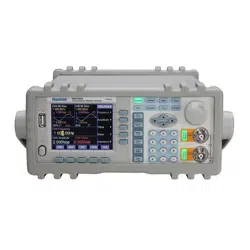Loading ...
Loading ...
Loading ...

3.10.3 Set the Interval Time
Select “Interval” option by the corresponding soft key. The interval time value changes to yellow. Input a new
interval time data here by numeric keypad or rotary dial. Press the key corresponding to the time units to confirm
the new data input.
3.11 Phase Shift Keying (PSK)
Press key [SK] to select “CHA PSK” function by the corresponding soft key. The function generator outputs the
PSK signal on the CHA Output. The upper-left portion of the TFT displays a PSK waveform. The phase of the
output signal is the alternative variation of the reference phase and the hop phase. The interval time of alternation
is adjustable.
3.11.1 Set the Hop Phase
Select “Hop Phase” option by the corresponding soft key. The hop phase value changes to yellow. Input a new
hop phase data here by numeric keypad or rotary dial. Press the key that corresponds to [°] to confirm the new
data input. The resolution of the hop phase is 11.25 degree. If users enter the phase value by using the numeric
keypad, the instrument will round the input value to the number of times of 11.25 degree.
3.11.2 Set the Interval Time
Select “Interval Time” option by the corresponding soft key. The interval time value is shown by yellow on the
TFT display. Input a new interval time here by numeric keypad or rotary dial. Press the key corresponding to the
time units to confirm the new data input.
3.11.3 PSK Observation
Due to the phase variation caused by PSK signal, it is hard to have synchronization on the oscilloscope, and
therefore cannot observe a stable waveform. If the frequency of the channel B is set at the same value of carrier
frequency, and use channel B signals as synchronization burst signals, a stable PSK signal waveform can be
observed.
However, the PSK waveform displayed on the TFT is just an extreme special case for the purpose of direct and
easy explanation of PSK process. There are conditions for operating the special case: the carrier signal period
should be exactly same as the interval time of two alternative phase signals, hop phase at 180° and hop at the
phase value of 0°. In practices, it is very difficult to meet the conditions required. If we set the carrier frequency at
1Hz, interval time as 1s, hop phase at 180°, we can observe a similar waveform on the oscilloscope. But the
waveform can only stay for a very short time, because the actual interval time is not exactly same as carrier
frequency period. Adjust the interval time to make it as close as possible to the carrier frequency period, so as to
have a longer display of the waveform.
3.12 Measure External Frequency
This function is available only when the user chooses to install the frequency counter.
Press key [COUNT] to go to the external measurement mode. The TFT display shows the external measurement
interface. In this mode, the instrument can be used as a frequency counter and measures the frequency value of the
external signal.
- 22 -
Loading ...
Loading ...
Loading ...
